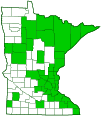Mock Oyster Mushroom
(Phyllotopsis nidulans)
Conservation • Description • Habitat • Ecology • Distribution • Taxonomy
|
|
||||||||||||||
Description |
Mock Oyster Mushroom is a common, colorful, stinky, gilled mushroom. It occurs across the Northern Hemisphere in Europe, Asia, North America, and Central America. It is found in groups or in overlapping clusters in the cool spring and fall but not in the hot summer. It grows on rotting logs and stumps of both deciduous and coniferous trees. It gets its nutrients from decaying wood (saprobic). When it first appears, the cap is convex and bright orange. The surface is densely covered with coarse to soft, whitish hairs, sometimes obscuring the colored surface. The margin is rolled under. As it ages, it spreads out, becoming semicircular, and the color fades. The mature cap is ¾″ to 3⅛″ (2 to 8 cm) wide, fan shaped, orangish yellow or yellowish orange, and convex above but flat below (planoconvex). It is attached to the substrate at one side, and there is usually no stalk. The surface is dry and densely hairy. It bruises easily, sometimes turning brownish when handled. It usually has a strong, very disagreeable odor, but the odor is sometimes mild. The gills are colored like the cap, bright orange, orangish yellow, or yellowish orange, sometimes paler. They are narrow and closely spaced to almost crowded. Between the main gills, there are frequent short gills that do not extend to the base. The stalk, if there is one, is rudimentary. The flesh is thin, soft or tough, and colored like the cap or paler. It does not change color when sliced. The edibility is unknown, and is likely to remain so, due to the unpleasant odor and tough texture. The spore print is pale pink, orangish pink, or pinkish brown. |
Similar Species |
Phyllotopsis subnidulans is a deeper orange and it has thinner gills that are spaced wider apart. It occurs in the eastern United States, but it has not been recorded in Minnesota. Based on the few records of this species, it is rare. |
Habitat and Hosts |
Rotting logs and stumps of both deciduous and coniferous trees |
Ecology |
Season |
Spring and fall |
Distribution |
||
|
Sources |
|
| 2/22/2024 | ||
Occurrence |
||
Common and widespread |
||
Taxonomy |
|
Kingdom |
Fungi (Fungi) |
Subkingdom |
Dikarya |
Phylum |
Basidiomycota (Basidiomycete Fungi) |
Subphylum |
Agaricomycotina (Higher Basidiomycetes) |
Class |
Agaricomycetes (Mushrooms, Bracket Fungi, Puffballs, and Allies) |
Subclass |
Agaricomycetidae |
Order |
|
Suborder |
Phyllotopsidineae |
Family |
Phyllotopsidaceae |
Genus |
Phyllotopsis |
This species was first described in 1798 Christian Hendrik Persoon as Agaricus nidulans. Since then, it has been described by many others under many names. |
|
Subordinate Taxa |
|
|
|
Synonyms |
|
Agaricus jonquilla Agaricus nidulans Agaricus odorativus Claudopus nidulans Crepidotus jonquilla Crepidotus nidulans Dendrosarcus mollis Dendrosarcus nidulans Lentinus stevensonii Panellus nidulans Panus foetens Panus nidulans Panus stevensonii Phyllotus nidulans Pleuropus nidulans Pleurotus nidulans Pocillaria stevensonii |
|
Common Names |
|
Mock Oyster Mushroom Nestcap Orange Mock Oyster Orange Oyster Smelly Oyster Stinking Orange Oyster |
|
Glossary
Saprobic
A term often used for saprotrophic fungi. Referring to fungi that obtain their nutrients from decayed organic matter.
Visitor Photos |
||
Share your photo of this fungus. |
||
This button not working for you? |
||
Blyke |
||
Found February 21st on the trails of Cleary Lake. |
||
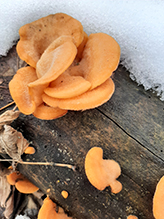 |
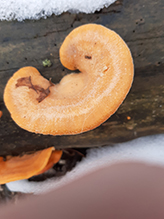 |
|
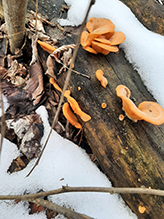 |
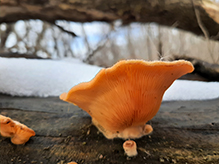 |
|
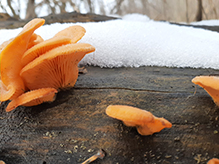 |
|
|
MinnesotaSeasons.com Photos |
||
|
||
|
||

Slideshows |
|

Visitor Videos |
||
Share your video of this fungus. |
||
This button not working for you? |
||
|
Other Videos |
||
Phyllotopsis nidulans / The Mock Oyster Mushroom (4K) |
About
Feb 14, 2020 |
Phyllotopsis nidulans (Mock Oyster Mushroom ) |
About
Jan 1, 2022 |
Orange mock oyster mushroom, Phyllotopsis nidulans: Cabbage-smelling, furry orange fungi FTW? |
About
Dec 24, 2023 Learn how to identify a bright orange mushroom known as the orange mock oyster, Phyllotopsis nidulans. Though nontoxic, people don't eat Phyllotopsis nidulans, and some of them smell preposterously bad–including the one featured in this video. When the weather cools, this semi-common fungus emerges on decaying wood in overlapping clusters. Identification features include: |
Mock Oyster vs Oyster mushroom (Phyllotopsis nidulans vs Pleurotus ostreatus) |
About
Dec 16, 2021 Showing examples of both mock oyster and oyster mushrooms and discussing some of the differences between the two. The mock oyster is inedible, but nontoxic. |

|
Created: 2/22/2024 Last Updated: © MinnesotaSeasons.com. All rights reserved. |
